| Palaeos: Mesozoic |  |
Mesozoic Era |
| Mesozoic Era | Mesozoic - 1 |
| Page Back | Back: Paleozoic | Back: Neoproterozoic | Up: Phanerozoic | Unit Home |
| Page Next | Next: Cenozoic | Down: Triassic | Timescale |
| Palaeos: Mesozoic |  |
Mesozoic Era |
| Mesozoic Era | Mesozoic - 1 |
| Page Back | Back: Paleozoic | Back: Neoproterozoic | Up: Phanerozoic | Unit Home |
| Page Next | Next: Cenozoic | Down: Triassic | Timescale |
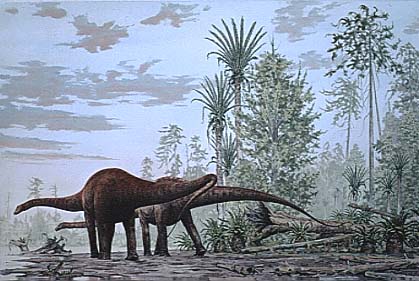 The supercontinent Pangea divides into Laurasia in the north and Gondwana in the south. The climate is hot and tropical worldwide. On land, the dinosaurs reign supreme. In the oceans are various kinds of marine reptiles, as well as ammonite and belemnite
molluscs and many other invertebrate groups. Plants include ferns and gymnosperms. Mammals are small and insignificant, but probably numerically common.
The supercontinent Pangea divides into Laurasia in the north and Gondwana in the south. The climate is hot and tropical worldwide. On land, the dinosaurs reign supreme. In the oceans are various kinds of marine reptiles, as well as ammonite and belemnite
molluscs and many other invertebrate groups. Plants include ferns and gymnosperms. Mammals are small and insignificant, but probably numerically common.
The Mesozoic Era lasted more than 180 million years. During this time, many modern forms of plants, invertebrates, and fishes evolved. On land, dinosaurs were the dominant animals, while the oceans were populated by large marine reptiles, and Pterosaurs ruled the air. For most of this period, the climate worldwide was warm and tropical, and shallow seas covered low-lying landmasses. At the beginning of the Mesozoic, all of the world's continents were joined into the supercontinent of Pangea, which rifted into Laurasia in the north and Gondwanaland in the south. By the end of the era most of continents had separated into their present form.
The Mesozoic Era is divided into three periods, each lasting many millions of years: the Triassic, Jurassic, and Cretaceous. The Triassic saw the emergence of many modern invertebrate groups, and on land the archosaur reptiles replaced the therapsids. In the oceans Ichthyosaurs such as Shonisaurus became as large as whales. The Jurassic was the height of the dinosaur era, with giants such as Brachiosaurus, Stegosaurus, etc, and mammals tiny and shrew-like. Distinctive plants like ferns, Cycads, Bennettitales, and Cheirolepidiaceae conifers characterized the landscape. During the Cretaceous period, the first flowering plants appeared, birds and fish diversified, and new types of dinosaurs appeared. The climate cooled and unique dinosaurs evolved on different continents.
The Mesozoic era came to an end with the great terminal extinction event known as the K-T (Cretaceous-Tertiary) event.
Image: illustration © Doug Henderson, reproduced with permission
| Range (Mya) | Duration (My) | |||
|---|---|---|---|---|
| Cretaceous K | Upper/late K2 | Maastrichtian k6 | 70.6 - 65.5 | 5.1 |
| Campanian k5 | 83.5 - 70.6 | 12.9 | ||
| Santonian k4 | 85.8 - 83.5 | 2.3 | ||
| Coniacian k3 | 89.3 - 85.8 | 3.5 | ||
| Turonian k2 | 93.5 - 89.3 | 4.2 | ||
| Cenomanian k1 | 99.6 - 93.5 | 6.1 | ||
| Lower/early K1 | Albian b6 | 112.0 - 99.6 | 12.4 | |
| Aptian b5 | 125.0 - 112.0 | 13.0 | ||
| Barremian b4 | 130.0 - 125.0 | 5.0 | ||
| Hauterivian b3 | 136.4 - 130.0 | 6.4 | ||
| Valanginian b2 | 140.2 - 136.4 | 3.8 | ||
| Berriasian b1 | 145.5 - 140.2 | 5.3 | ||
| Jurassic J | Upper/late J3 | Tithonian j7 | 150.8 - 145.5 | 5.3 |
| Kimmeridgian j6 | 155.7 - 150.8 | 4.9 | ||
| Oxfordian j5 | 161.2 - 155.7 | 5.5 | ||
| Middle J2 | Callovian j4 | 164.7 - 161.2 | 3.5 | |
| Bathonian j3 | 167.7 - 164.7 | 3.0 | ||
| Bajocian j2 | 171.6 - 167.7 | 3.9 | ||
| Aalenian j1 | 175.6 - 171.6 | 4.0 | ||
| Lower/early J1 | Toarcian l4 | 183.0 - 175.6 | 7.4 | |
| Pliensbachian l3 | 189.6 - 183.0 | 6.6 | ||
| Sinemurian l2 | 196.5 - 189.6 | 6.9 | ||
| Hettangian l1 | 199.6 - 196.5 | 3.1 | ||
| Triassic T | Upper/late T3 | Rhaetian t7 | 203.6 - 199.6 | 4.0 |
| Norian t6 | 216.5 - 203.6 | 12.9 | ||
| Carnian t5 | 228.0 - 216.5 | 11.5 | ||
| Middle T2 | Ladinian t4 | 237.0 - 228.0 | 9.0 | |
| Anisian t3 | 245.0 - 237.0 | 8.0 | ||
| Lower/early T1 | Olenekian t2 | 249.7 - 245.0 | 4.7 | |
| Induan t1 | 251.0 - 249.7 | 1.3 |
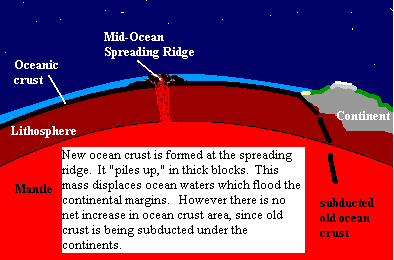 Some of the main outlines of Mesozoic climate are matters of general
agreement, but almost no one is very satisfied
with the explanations for what has been observed. Here's the usual story:
Some of the main outlines of Mesozoic climate are matters of general
agreement, but almost no one is very satisfied
with the explanations for what has been observed. Here's the usual story:
The Triassic, particularly the first half of the Triassic, was dry and highly seasonal, with particularly large annual temperature variations in the vast continental interior of Pangea, the world-spanning continent of the Triassic. Low sea levels probably exaggerated these temperature extremes. Water acts as a heat sink -- it takes much more heat to warm a cup of water than it does to warm a cup of rock. Water also circulates, so that heat doesn't build up in one place. The net result is that water tends to stabilize temperatures. Land areas near the ocean are warmed or cooled by winds which pass over the ocean and by rains from evaporated ocean waters. It is generally agreed (a) that the low sea levels of the Triassic contributed to temperature extremes in the interior of Pangea and (b) that the interior of Pangea probably included huge areas of desert.
 During the Jurassic,
sea levels began to rise, probably due to an increase in sea-floor
spreading. This seems paradoxical, but the mechanism is explained in the
image. This caused flooding of large areas of the continents.
As a result, the deserts began to retreat, and continental temperatures
stabilized. Pangea also began to break up into smaller units, which
brought more land area in contact with the ocean. The presence of nearby
oceans also increased humidity, so that climates worldwide became wetter as well
as warmer.
During the Jurassic,
sea levels began to rise, probably due to an increase in sea-floor
spreading. This seems paradoxical, but the mechanism is explained in the
image. This caused flooding of large areas of the continents.
As a result, the deserts began to retreat, and continental temperatures
stabilized. Pangea also began to break up into smaller units, which
brought more land area in contact with the ocean. The presence of nearby
oceans also increased humidity, so that climates worldwide became wetter as well
as warmer.
During the first half of the Cretaceous, this process continued. In addition two climate trends which began in the Jurassic became quite pronounced in the Cretaceous. The mechanism for these events is not fully understood. First, the temperature gradient from North to South became almost flat -- much more so than would be predicted from ocean circulation models. In other words, average temperatures were about the same everywhere on Earth, from the poles to the equator. Second, average temperatures were much higher than today, probably by about 10C°. Higher CO2 (carbon dioxide) levels certainly played a part, but the paleoclimate data do not match theoretical predictions.
The later Cretaceous story is more complex, and more controversial. Many researchers, but not a real consensus, believe that sea temperatures near the equator may have become a bit too warm by the Aptian-Albian, perhaps actually incompatible with ocean life. In addition, some data suggest that land areas near the equator were not jungle- or forest-covered, that plant diversity was low, and that these regions were arid despite being close to the sea. Deep ocean circulation may also have broken down. That is, water continued to circulate horizontally, but not vertically. The deep oceans weren't getting oxygen, and "black shales" appeared in the Aptian-Albian and High Cretaceous. These are large volumes of organic matter in the oceans which never completely decomposed because of lack of deep ocean oxygen. Still, the north-south temperature gradient remained very flat.
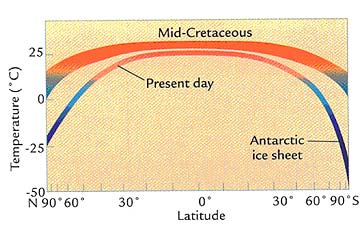 Things
cooled off a little during the End-Cretaceous, but it's unclear how much or how
regularly. The climate at the very end of the Mesozoic is
particularly controversial.
Things
cooled off a little during the End-Cretaceous, but it's unclear how much or how
regularly. The climate at the very end of the Mesozoic is
particularly controversial.
Unfortunately, the data only match this story to a limited degree, and there are internal inconsistencies. Here are a few of the problem areas.
1) If temperature extremes in the Triassic were as great as general circulation models predict, one would expect rather hefty ice-build-up in at least some polar regions. Glaciers leave a rather distinct geological signature, and we simply don't have any evidence of Triassic glaciers or polar caps.
2) Conversely, there is evidence of the kind of rapid sea level changes associated with polar ice in the Mid-Cretaceous, which is rather hard to accept. Miller et al. (2003).
3) CO2 levels are usually invoked to explain Cretaceous warmth and the flat Cretaceous temperature gradient. This makes sense, since the very active mid-ocean spreading ridges might well have been associated with out-gassing of CO2 from deep within the Earth. Unfortunately, neither the geology of the period nor the stable carbon isotope records really support the idea as well as they might.
4) Even the most sophisticated quantitative models can't reconstruct the flatness of the Cretaceous temperature gradient. Either our temperature estimates are off, or some important factor is missing from the models. Since dinosaurs and semi-tropical vegetation are known from within 10° of the Cretaceous poles, the problem is likely to be with the theory. A recent study of a mid-latitude continental interior (in eastern Russia) -- far from the ocean in even Late Cretaceous times, suggest that temperatures were very even and that these regions were damp and non-seasonal even in the Mid-Cretaceous.
Links: Mesozoic Dinosaurs - Enchanted Learning Software, Lecture 24-, Global Climate Change Student Guide, Pz-Mzclimate, Global Climate and Phytogeography in the Early Mesozoic, Pangaean climate during the Early Jurassic- GCM simulations and ..., The Vilui Basin and the Late Cretaceous Continental Interior ..., Mesozoic LAND ECOSYSTEMS, Geological Society - Abstracts.
ATW041023. Text and ocean crust image public domain. No rights reserved.

Dragonfly |

Bivalve |

Ammonite |

Belemnite |

Pterosauria |

Crinoid |
Araucariacean conifer |

Bennettitale |
 Calcareous Sponge |
Ichthyosaur |

Plesiosaur |

Dinosaur |

Echinoid |

Fern |
 If you're looking at this section, you may be a beginner without much
previous knowledge. Of course, you may simply have been searching the web
for an old Nirvana
CD and you ran across this page because, as it happens, you're also a
moron. In either case, it is unlikely that you have much background in
Mesozoic zoology (or, for that matter, much taste in music).
Accordingly, we'll keep this pretty basic and concentrate on the familiar tetrapods.
If you're looking at this section, you may be a beginner without much
previous knowledge. Of course, you may simply have been searching the web
for an old Nirvana
CD and you ran across this page because, as it happens, you're also a
moron. In either case, it is unlikely that you have much background in
Mesozoic zoology (or, for that matter, much taste in music).
Accordingly, we'll keep this pretty basic and concentrate on the familiar tetrapods.
The Mesozoic came after the Paleozoic. The Paleozoic Era ended with the Permian Period, which ended with a sort of general meltdown, sometimes called the "PT" or "End-Permian" extinction. We still aren't certain exactly what happened, but the fact that much of central Siberia turned into a sort of volcanic bubble bath for a few million years didn't help. This was, bar none, the worst mass extinction in the last 600 My. Don't get this one confused with the "KT" extinction at the end of the Mesozoic -- the one which finished off the dinosaurs 200 My later. That was a sumo match by comparison. That is, it eliminated some very large and conspicuous folks very quickly, but it was all very fast and civilized.
The PT extinction dragged on for at least a few hundred thousand years and resulted in the loss of perhaps 98-99% of all species of animals. The survivors of the End-Permian radiated into a world that was rather empty, and the new life forms that evolved from those survivors were sometimes quite different from those whch had come before. For example, of all the therapsids (mammal ancestors) in the world at the end of the Permian, only a few cynodonts and dicynodonts were left. Not surprisingly, they multiplied like rabbits and spread out all over the world. As they did, they encountered environments and ecological challenges quite different from those in their South African (probably) home base. So, different populations evolved in different directions.
In addition, the great legion of their dinocephalian
cousins had vanished completely, leaving those large-herbivore and carnivore
jobs empty. Some of those slots were filled by newly modified cynodonts and
dicynodonts; but, many of those positions were taken over by archosaurian
reptiles, instead. So, not only were the surviving groups changed in
composition, but the balance between them changed as well. Among the
tetrapods, the newly expanded range of the archosaurs created an opening for the
evolution of the archosaurian dinosaurs
and pterosaurs, both of
which appeared just a 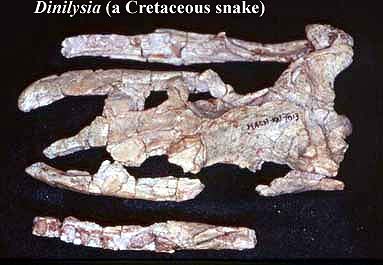 few million years after the PT extinction. These
went on to drive the dicynodonts to extinction and reduce the cynodonts to a
marginal population of small, furtive night-dwellers -- the mammals.
A similar, but larger, set of vacancies in the marine job market created new
opportunities for other major reptile lines, which evolved several different
groups of specialized sea-going forms, including the sauropterygians
(plesiosaurs and their kin), ichthyosaurs,
and mosasaurs.
few million years after the PT extinction. These
went on to drive the dicynodonts to extinction and reduce the cynodonts to a
marginal population of small, furtive night-dwellers -- the mammals.
A similar, but larger, set of vacancies in the marine job market created new
opportunities for other major reptile lines, which evolved several different
groups of specialized sea-going forms, including the sauropterygians
(plesiosaurs and their kin), ichthyosaurs,
and mosasaurs.
This same story could be told about molluscs and echinoderms and even plants, which suffered much less than animals from the effects of the PT events. In each case, one or two of the big groups were completely eliminated, the rest were changed, and the old ecological balances of the Paleozoic were very thoroughly unbalanced. The entire Triassic, and most of the Jurassic, was spent getting all that sorted out. At the end of this period -- about the Late Jurassic and earliest Cretaceous -- there was another burst of evolutionary creativity associated with rising seas and relatively warm, equable climate throughout the world. Familiar examples include birds, placental mammals and angiosperm (flowering) plants. Again, even more fundamental changes were going on in the sea: rudist molluscs, new types of sharks, planktonic foraminifera, and several new types of algae, to name but a few.
Both temperature and sea level reached maxima in Aptian-Albian time, or perhaps a little later. By this time, things were getting a bit too warm in the seas, and there was some climatic deterioration. The Late Cretaceous saw a remarkable evolution of smaller animals of all kinds, perhaps at the expense of the giants of earlier Mesozoic ages. So, for example, we find the first examples of modern lizards and snakes, and mammals which were probably primates.
Of course, all these vermin might have come to nothing if a small asteroid hadn't happened to land in Mexico, 65.5 Mya. But it did, and the cycle of disaster, evolution, dispersal, and recovery continued. Speaking of which, if you're still interested in that Nirvana CD, forget it. Sure, Cobain could have been the TS Elliot of the Twenty-First Century had he, likewise, taken a different path. But he didn't either, and its just no use pretending otherwise.
ATW050205. Text public domain. No rights reserved.
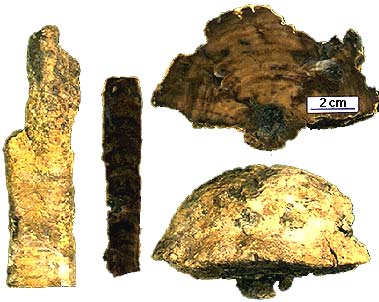 It
is easy to type "Mesozoic Reef Systems," just as it is
easy to type the words "The History of the Asia." In both cases,
it's a bit harder to say anything meaningful in a few words. We might try a
few verbal pictures instead.
It
is easy to type "Mesozoic Reef Systems," just as it is
easy to type the words "The History of the Asia." In both cases,
it's a bit harder to say anything meaningful in a few words. We might try a
few verbal pictures instead.
The Mesozoic began with the universal desolation of the end-Permian world. Most reef systems were devastated beyond recovery. The frothy and exhuberant dream castles of Late Permian calcareous sponge were were now in ruins -- crumbling blocks of lifeless rock, around which no fishes swam. Instead, there sprouted, here and there, the squat and flaccid mushroom shapes of pale stromatolites. These glowed a ghost-like green against the garish, toxic shades of fungal blooms which gnawed like ghouls opon the last decaying flesh of Permian life. The seas were weirdly clear. The rich planktonic rains of fusilinid forams, diatoms, and softer-bodied forms, uncounted and unknown, were gone. In deeper seas, the drifting galaxies of crystal radiolarian stars were swept away. All ocean life was strangled by anoxic waters reaching through unheard-of depths; and nothing lived that did not feed on death.
Almost two million centuries later it closed with a riot of shape and of form, leaving reefs made of corals and sponges and clams, leaving mountains of algae and snails, leaving brachiopods by the billion or more, leaving walls built by rudists on carbonate platforms with foraminiferan floors. For throughout the Triassic, Jurassic, Cretaceous, the oceans continued to rise. And as long as the waters continued to rise, the corals continued to grow. Like the rudists and algae and sponges and clams, they grew to the tops of their tropical seas, where the sun made a tropical glow.
While an interesting exercise, the attempt to deliver scientific information in blank verse suffers from certain unavoidable inefficiencies. We will therefore return to our regular bland diet of tasteless literary grits -- with but with an occasional metrical lapse for particular pieces and bits. ATW040909.
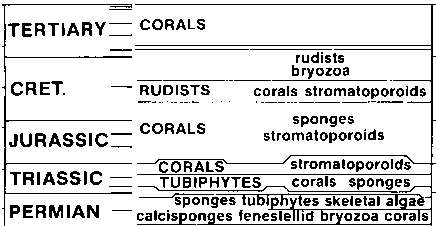 Image: Jurassic corals from Jurassic
Reef Park
Image: Jurassic corals from Jurassic
Reef Park
ATW 2004. Text public domain. No rights reserved.
| Page Back | Unit Home | Page Up | Page Top | Page Next |